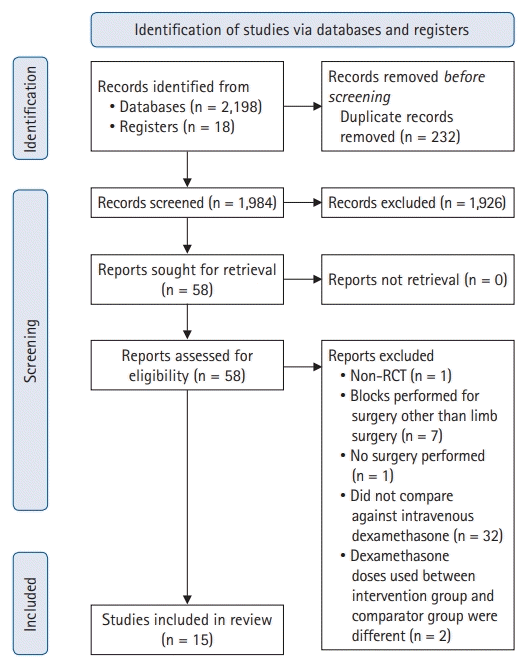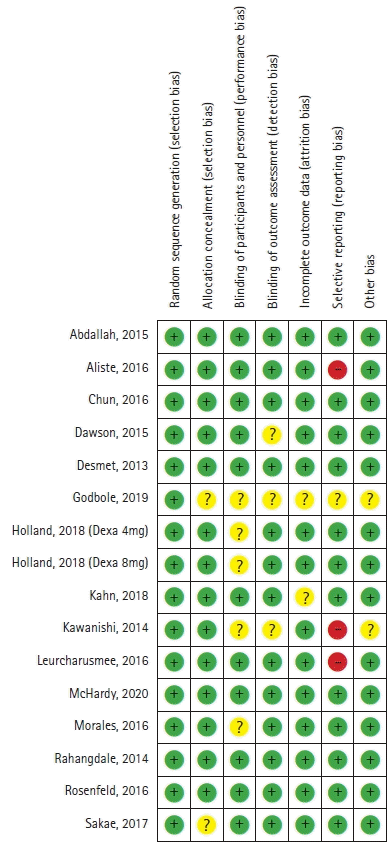1. Cardwell TW, Zabala V, Mineo J, Ochner CN. The effects of perioperative peripheral nerve blocks on peri- and postoperative opioid use and pain management. Am Surg 2021: 31348211023395.
2. Munoz-Leyva F, Cubillos J, Chin KJ. Managing rebound pain after regional anesthesia. Korean J Anesthesiol. 2020; 73:372–83.

3. Joshi GP. Multimodal analgesia techniques and postoperative rehabilitation. Anesthesiol Clin North Am. 2005; 23:185–202.

4. Volk T, Engelhardt L, Spies C, Steinfeldt T, Gruenewald D, Kutter B, et al. Incidence of infection from catheter procedures for regional anesthesia: first results from the network of DGAI and BDA. Anaesthesist. 2009; 58:1107–12.
5. Huynh TM, Marret E, Bonnet F. Combination of dexamethasone and local anaesthetic solution in peripheral nerve blocks: A meta-analysis of randomised controlled trials. Eur J Anaesthesiol. 2015; 32:751–8.
6. Pehora C, Pearson AM, Kaushal A, Crawford MW, Johnston B. Dexamethasone as an adjuvant to peripheral nerve block. Cochrane Database Syst Rev. 2017; 11:CD011770.

7. Albrecht E, Kern C, Kirkham KR. A systematic review and meta-analysis of perineural dexamethasone for peripheral nerve blocks. Anaesthesia. 2015; 70:71–83.

8. Barnes PJ. Anti-inflammatory actions of glucocorticoids: molecular mechanisms. Clin Sci (Lond). 1998; 94:557–72.

9. Johansson A, Hao J, Sjolund B. Local corticosteroid application blocks transmission in normal nociceptive C-fibres. Acta Anaesthesiol Scand. 1990; 34:335–8.

10. Shishido H, Kikuchi S, Heckman H, Myers RR. Dexamethasone decreases blood flow in normal nerves and dorsal root ganglia. Spine (Phila Pa 1976). 2002; 27:581–6.

11. Baeriswyl M, Kirkham KR, Jacot-Guillarmod A, Albrecht E. Efficacy of perineural vs systemic dexamethasone to prolong analgesia after peripheral nerve block: a systematic review and meta-analysis. Br J Anaesth. 2017; 119:183–91.

12. Hussain N, Van den Langenbergh T, Sermer C, Fontes ML, Atrey A, Shaparin N, et al. Equivalent analgesic effectiveness between perineural and intravenous dexamethasone as adjuvants for peripheral nerve blockade: a systematic review and meta-analysis. Can J Anaesth. 2018; 65:194–206.

13. Zhao WL, Ou XF, Liu J, Zhang WS. Perineural versus intravenous dexamethasone as an adjuvant in regional anesthesia: a systematic review and meta-analysis. J Pain Res. 2017; 10:1529–43.

14. Godbole MR, Karhade SS, Parihar PP. A Prospective Study of Comparison of Analgesic Efficacy of Dexamethasone as an Adjuvant in Supraclavicular Block with Intravenous Dexamethasone after Supraclavicular Block in Patients Undergoing Forearm Surgeries. Anesth Essays Res. 2019; 13:31–5.

15. Holland D, Amadeo RJ, Wolfe S, Girling L, Funk F, Collister M, et al. Effect of dexamethasone dose and route on the duration of interscalene brachial plexus block for outpatient arthroscopic shoulder surgery: a randomized controlled trial. Can J Anaesth. 2018; 65:34–45.

16. McHardy PG, Singer O, Awad IT, Safa B, Henry PD, Kiss A, et al. Comparison of the effects of perineural or intravenous dexamethasone on low volume interscalene brachial plexus block: a randomised equivalence trial. Br J Anaesth. 2020; 124:84–91.

17. Kahn RL, Cheng J, Gadulov Y, Fields KG, YaDeau JT, Gulotta LV. Perineural low-dose dexamethasone prolongs interscalene block analgesia with bupivacaine compared with systemic dexamethasone: a randomized trial. Reg Anesth Pain Med. 2018; 43:572–9.
18. Moher D, Liberati A, Tetzlaff J, Altman DG. Preferred reporting items for systematic reviews and meta-analyses: the PRISMA statement. J Clin Epidemiol. 2009; 62:1006–12.

19. Higgins JP, Altman DG, Gotzsche PC, Juni P, Moher D, Oxman AD, et al. The Cochrane Collaboration's tool for assessing risk of bias in randomised trials. BMJ. 2011; 343:d5928.

20. Langendam MW, Akl EA, Dahm P, Glasziou P, Guyatt G, Schunemann HJ. Assessing and presenting summaries of evidence in Cochrane Reviews. Syst Rev. 2013; 2:81.

21. ANZCA FoPM. Opioid Calculator [Internet]. Melbourne: Faculty of Pain Medicine, The Australian and New Zealand College of Anaesthetists;2019. [cited 2021 Oct 1]. Available from:
http://www.opioidcalculator.com.au.
22. Hozo SP, Djulbegovic B, Hozo I. Estimating the mean and variance from the median, range, and the size of a sample. BMC Med Res Methodol. 2005; 5:13.

23. Naim HE, Elshafaie KA, Soaida SM, Abdel-Haq MM, Nawar KM. Systemic versus perineural dexamethasone as an adjuvant to bupivacaine in combined femoral and sciatic nerve blocks in lower-limb vascular surgeries: a prospective randomized study. Ain-Shams J Anaesthesiol. 2016; 9:569–75.

24. Basset B, Merouani M, Marquis C, Bataille B, Chaubard M, Mailles MC, et al. Perineural Versus Systemic Dexamethasone in Front-Foot Surgery Under Ankle Block: A Randomized Double-Blind Study. Reg Anesth Pain Med. 2018; 43:732–7.
25. Marhofer P, Columb M, Hopkins PM, Greher M, Marhofer D, Bienzle M, et al. Dexamethasone as an adjuvant for peripheral nerve blockade: a randomised, triple-blinded crossover study in volunteers. Br J Anaesth. 2019; 122:525–31.

26. Morales-Munoz C, Sanchez-Ramos JL, Diaz-Lara MD, Gonzalez-Gonzalez J, Gallego-Alonso I, Hernandez-Del-Castillo MS. Analgesic effect of a single-dose of perineural dexamethasone on ultrasound-guided femoral nerve block after total knee replacement. Rev Esp Anestesiol Reanim. 2017; 64:19–26.

27. Dawson RL, McLeod DH, Koerber JP, Plummer JL, Dracopoulos GC. A randomised controlled trial of perineural vs intravenous dexamethasone for foot surgery. Anaesthesia. 2016; 71:285–90.

28. Rahangdale R, Kendall MC, McCarthy RJ, Tureanu L, Doty R Jr, Weingart A, et al. The effects of perineural versus intravenous dexamethasone on sciatic nerve blockade outcomes: a randomized, double-blind, placebo-controlled study. Anesth Analg. 2014; 118:1113–9.
29. Desmet M, Braems H, Reynvoet M, Plasschaert S, Van Cauwelaert J, Pottel H, et al. I.V. and perineural dexamethasone are equivalent in increasing the analgesic duration of a single-shot interscalene block with ropivacaine for shoulder surgery: a prospective, randomized, placebo-controlled study. Br J Anaesth. 2013; 111:445–52.

30. Kawanishi R, Yamamoto K, Tobetto Y, Nomura K, Kato M, Go R, et al. Perineural but not systemic low-dose dexamethasone prolongs the duration of interscalene block with ropivacaine: a prospective randomized trial. Local Reg Anesth. 2014; 7:5–9.
31. Abdallah FW, Johnson J, Chan V, Murgatroyd H, Ghafari M, Ami N, et al. Intravenous dexamethasone and perineural dexamethasone similarly prolong the duration of analgesia after supraclavicular brachial plexus block: a randomized, triple-arm, double-blind, placebo-controlled trial. Reg Anesth Pain Med. 2015; 40:125–32. Erratum in: Reg Anesth Pain Med 2015; 40: 398.
32. Aliste J, Leurcharusmee P, Engsusophon P, Gordon A, Michelagnoli G, Sriparkdee C, et al. A randomized comparison between intravenous and perineural dexamethasone for ultrasound-guided axillary block. Can J Anaesth. 2017; 64:29–36.

33. Chun EH, Kim YJ, Woo JH. Which is your choice for prolonging the analgesic duration of single-shot interscalene brachial blocks for arthroscopic shoulder surgery? intravenous dexamethasone 5 mg vs. perineural dexamethasone 5 mg randomized, controlled, clinical trial. Medicine (Baltimore). 2016; 95:e3828.
34. Leurcharusmee P, Aliste J, Van Zundert TC, Engsusophon P, Arnuntasupakul V, Tiyaprasertkul W, et al. A multicenter randomized comparison between intravenous and perineural dexamethasone for ultrasound-guided infraclavicular block. Reg Anesth Pain Med. 2016; 41:328–33.

35. Rosenfeld DM, Ivancic MG, Hattrup SJ, Renfree KJ, Watkins AR, Hentz JG, et al. Perineural versus intravenous dexamethasone as adjuncts to local anaesthetic brachial plexus block for shoulder surgery. Anaesthesia. 2016; 71:380–8.

36. Sakae TM, Marchioro P, Schuelter-Trevisol F, Trevisol DJ. Dexamethasone as a ropivacaine adjuvant for ultrasound-guided interscalene brachial plexus block: A randomized, double-blinded clinical trial. J Clin Anesth. 2017; 38:133–6.

37. Laigaard J, Pedersen C, Rønsbo TN, Mathiesen O, Karlsen AP. Minimal clinically important differences in randomised clinical trials on pain management after total hip and knee arthroplasty: a systematic review. Br J Anaesth. 2021; 126:1029–37.

38. Dani C, Vestri V, Bertini G, Pratesi S, Rubaltelli FF. Toxicity of corticosteroids and catecholamines for mice neuronal cell cultures: Role of preservatives. J Matern Fetal Neonatal Med. 2007; 20:325–33.

39. Krishna Prasad BP, Joy B, Raghavendra VA, Toms A, George D, Ray B. Ultrasound-guided peripheral nerve interventions for common pain disorders. Indian J Radiol Imaging. 2018; 28:85–92.

40. Khan JS, Rai A, Sundara Rajan R, Jackson TD, Bhatia A. A scoping review of perineural steroids for the treatment of chronic postoperative inguinal pain. Hernia. 2016; 20:367–76.

41. Gan TJ, Belani KG, Bergese S, Chung F, Diemunsch P, Habib AS, et al. Fourth Consensus Guidelines for the Management of Postoperative Nausea and Vomiting. Anesth Analg. 2020; 131:411–48.





 PDF
PDF Citation
Citation Print
Print











 XML Download
XML Download